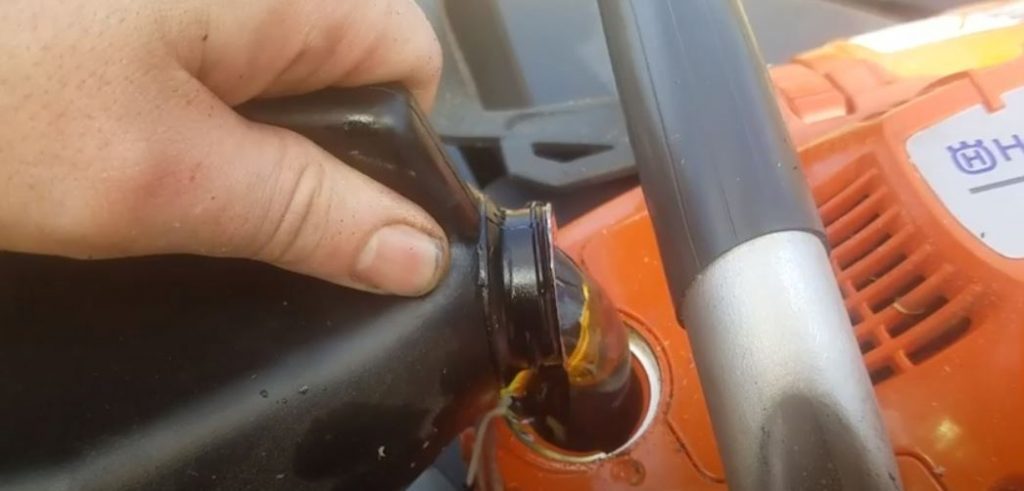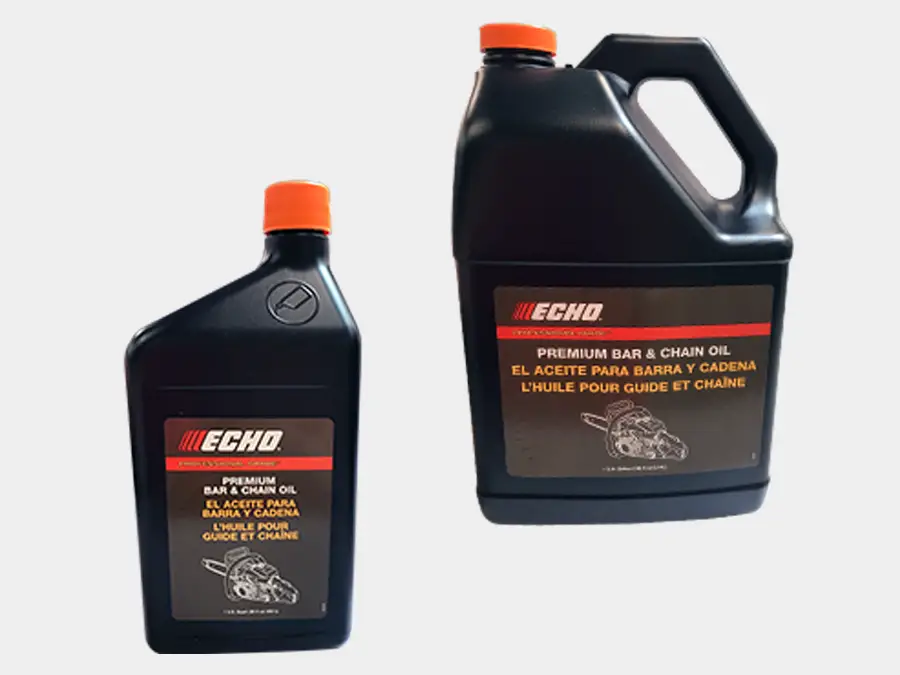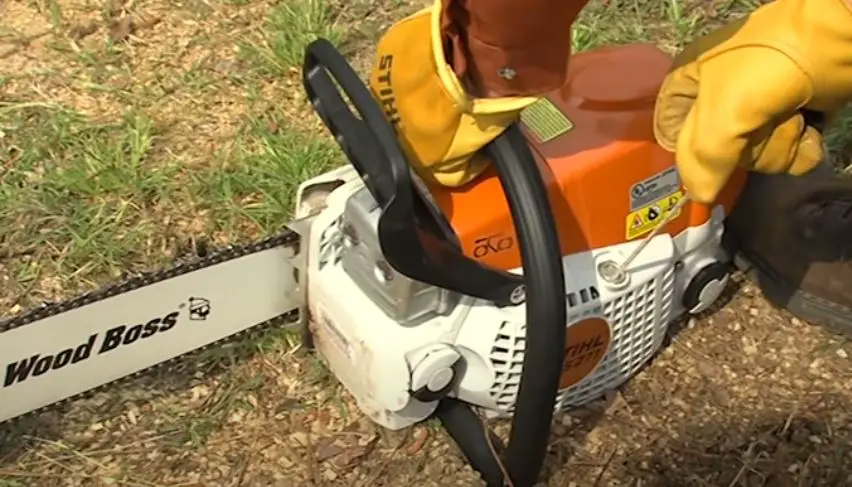Chainsaw bar oil is a specialized lubricant applied to the guide bar and chain, reducing friction and wear during operation. Use it every time you operate a chainsaw by filling the oil reservoir before starting the chainsaw, ensuring optimal performance, longer chain life, and safer cutting experience.
Refilling the machine with fuel and bar oil is one of the most confusing parts of operating a chainsaw for beginners. But what is chainsaw bar oil, and what purpose does it serve?
I have used chainsaws extensively for many years and have put together this guide to explain all the aspects of bar oil before operating your chainsaw.
Table of Contents
Why Do Chainsaws Need Bar Oil?
Bar oil is used to lubricate the metal components of a chainsaw between the chain and the bar guide. These chainsaw’s high rotating parts create a lot of heat and friction. Oil is essential to lubricate this zone but is not sealed to the environment, so you will lose oil during operation.
The loss of oil between the chain and the bar is called ‘sling’. This oil can damage the environment if it leaks onto vegetation and must be replaced after use. The right bar oil selection for your chainsaw and the temperature is crucial to minimizing oil loss.
Manufacturers generally build chainsaws with an oil reservoir that loses 1/2 of its volume for every tank of gas used. This means you must refill your oil reservoir every time you refuel your chainsaw to ensure it never runs empty.

Different Grades of Bar Oil
There are plenty of different types and grades of oil that you can use to lubricate your chainsaw. These vary in chemical structure and oil weight, impacting performance, availability and cost.
A common metric is the oil weight, with the lightest oil being 10W and up to 50W for the thickest. 30W oil is considered standard for chainsaws.
If you work in winter in cold climates, consider a thinner oil, down to 10W or 20W. Consider a thicker oil, up to 40W or 50W when working in hot environments.
You can also find additives in your oil that are used for multiple purposes:
- Reduce rust and corrosion
- Reduce oil sling, so you don’t need to replace your oil as frequently
- Maintain oil stickiness so you don’t find sap and debris sticking to the chain
There are also multiple types of oil that I will explain in more detail:
Standard Bar Oil
The first step is to check your chainsaw’s operating manual and find the manufacturer’s recommended oil. This will likely be a standard bar oil. This type of oil is very ‘sticky’ because it needs to stay in place even when the chain is spinning at fast speeds. Selecting an oil not designed for chainsaws means you will lose more oil as it leaks (or slings) during use.
There are other oil substitutes that you can use if you don’t have any standard bar oil on hand, but these each have their own advantages and disadvantages. The use of alternate bar oils can void your chainsaw’s warranty.

Motor Oil
The most likely oil alternative you may have in your garage is motor oil you use in your truck. This can be used in a pinch but it is far from ideal. Motor oil is not as sticky and does not have the same properties as bar oil. This means that you will leak more oil during use. You will find using motor oil in your chainsaw is downright messy.
This oil loss means you must refill your oil reservoir much more often. If you are distracted and run out of oil, you can seriously damage your chainsaw as the metal mechanical parts heat up and the friction increases.
This will also damage the environment as you lose motor oil around each log or tree you cut.
Vegetable Oil
Some locations require using biodegradable oils, such as vegetable oil in your chainsaw. This is because oil will slowly be released through small gaps between the bar and the chain, which can be released into the environment. If you have an environmentally friendly mindset and want to ensure you minimize any impact on the land, choose a bio-oil.
Canola Oil
Similar to vegetable oil, canola oil is biodegradable. It also can handle high heat caused by friction in the high-speed chainsaw. It is also better in cold climates, so if you work in winter, canola oil is a better, environmentally friendly alternative than vegetable oil.
If you have run out of standard bar oil, and are rummaging through your house for alternatives, vegetable oil and canola oil are my first picks.
How to Replace Bar Oil
Replacing the bar oil on your chainsaw is the same for gas and electric-powered machines. It is relatively simple if you adequately prepare with the correct tools.
Step 1 – Setup
Find the best type of oil you can access as recommended by your chainsaw’s manufacturer. You will need to add about 1/2 the oil reservoir per 1 tank of gas. Most chainsaws have oil reservoirs of between 5 and 10 fluid ounces, so ensure you have enough bar oil for the work you intend to do.
Place your chainsaw on a flat surface so the oil can level off, especially if it is cold and the oil is thicker. Pick a location where you can easily clean up any spilt oil, and use a funnel if you don’t aim well.
For gas-powered chainsaws, ensure the machine has cooled down enough.
For electric-powered chainsaws, ensure the battery has been removed, so the chain cannot accidentally start.
This is also a good time to inspect your chainsaw – does it need cleaning or does the chain need sharpening.

Step 2 – Add the Oil
Find the oil reservoir on your chainsaw (note – this is a different cap to your gas tank). Unscrew the cap and place it somewhere where it won’t get dust or dirt on the inside of the cap. Add enough oil to fill up the oil reservoir without overfilling or spilling. I recommend using a funnel so you don’t spill oil onto the ground or over the hot chainsaw.
Step 3 – Run the Chainsaw
I always run the chainsaw for a minute to ensure the oil pumps sufficiently lubricate the chain and the bar. This is particularly important if you have run low on oil, lost some lubrication, or haven’t run the chainsaw in a long time. Avoid getting straight into the hard work until the machine is fully lubricated.

How Often to Replace Bar Oil
Oil is lost (called oil sling) during operating because there is no seal between the chain and the bar. This means that you need to refill the oil reservoir extremely frequently. I recommend filling your bar oil every time you refill your fuel (or replace your battery in an electric chainsaw).
You will typically consume 1/2 a tank of bar oil per 1 tank of fuel for a gas chainsaw.
Running out of oil can cause severe damage to your chainsaw’s mechanical equipment due to the metal components’ high speed and high friction. I always recommend refilling your oil too frequently to avoid the rare possibility of running out of oil.
How Much Bar Oil Does a Chainsaw Use?
Chainsaws typically consume 1/2 a tank of bar oil per 1 tank of gasoline. You will generally find most chainsaws have oil reservoirs between 5 and 10 fluid ounces.
Why Do Chainsaws Lose Oil?
Chainsaw bar oil lubricates the fast-spinning chain between the bar guide. This is a high revolution and harsh environment. During each rotation, a small amount of oil is lost as droplets or mist as it sticks to the chain and is flung into the environment. Selecting the correct oil so that it is more likely to stick to the bar/chain is the best option for reducing oil sling (or leakage).
Conclusion
I hope this guide has explained what bar oil is and how important it is for the performance and longevity of your chainsaw. If you are looking for more information, this article by Garden Tool Expert adds more detail.
Maintaining your equipment is the best way to increase its durability and get the most value for money out of your gear. I have also put together a guide to the most affordable chainsaws on the market if you haven’t made a purchase yet.
